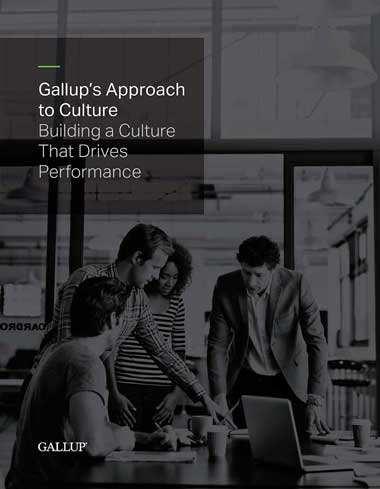Story Highlights
- Decisions made under COVID-19 pressure are exposing how work gets done
- Assessing the situation and then taking action can transform your workplace
- Communicate your best examples to create the culture you aspire to have
Gallup defines culture broadly: "The way work gets done around here." And we've spent years studying what makes a strong culture. Organizational culture involves a key set of touchpoints in the employee life cycle, including attraction, selection, development and engagement. These key concepts can strengthen a culture if done correctly, or weaken a culture if ignored.
The way that organizations get work done has been dramatically affected over the past two months. Many companies have stepped up, making tough decisions in real time to protect employees' and customers' wellbeing. In doing so, many have discovered that their aspirational culture already exists.
Other organizations have discovered leaders who act in a way that undercuts the culture they want. Amid elevated stress, some employees have exhibited self-centered, command-and-control, resource-hoarding behaviors that put customers and the organization's survival last on their list.
Some of the decisions being made by people under pressure are fear-based and do not bode well for creating and sustaining an engaged workplace. Whether it be stockpiling essential items for themselves or putting their own needs ahead of their coworkers', the rapidly transformed workplace environment due to the novel coronavirus outbreak has left some with a bad taste in their mouth and a muddy vision of their workplace.
So, how can we get a clearer view?
Look at Where You're Going
Recent Gallup Panel data show the effects that the pandemic has had on U.S. workers. Employers have frozen hiring, reduced hours or shifts, and cut jobs. These decisions were made swiftly -- but how many leaders took an appropriate look at their workplace culture before making them?
| Yes | No | Does not apply | ||||||||||||||||||||||||||||||||||||||||||||||||||||||||||||||||||||||||||||||||||||||||||||||||||
|---|---|---|---|---|---|---|---|---|---|---|---|---|---|---|---|---|---|---|---|---|---|---|---|---|---|---|---|---|---|---|---|---|---|---|---|---|---|---|---|---|---|---|---|---|---|---|---|---|---|---|---|---|---|---|---|---|---|---|---|---|---|---|---|---|---|---|---|---|---|---|---|---|---|---|---|---|---|---|---|---|---|---|---|---|---|---|---|---|---|---|---|---|---|---|---|---|---|---|---|---|
| % | % | % | ||||||||||||||||||||||||||||||||||||||||||||||||||||||||||||||||||||||||||||||||||||||||||||||||||
| Cut jobs | ||||||||||||||||||||||||||||||||||||||||||||||||||||||||||||||||||||||||||||||||||||||||||||||||||||
| 2020 Apr 20-26 | 19 | 73 | 8 | |||||||||||||||||||||||||||||||||||||||||||||||||||||||||||||||||||||||||||||||||||||||||||||||||
| 2020 Apr 13-19 | 19 | 70 | 11 | |||||||||||||||||||||||||||||||||||||||||||||||||||||||||||||||||||||||||||||||||||||||||||||||||
| 2020 Apr 6-12 | 14 | 74 | 13 | |||||||||||||||||||||||||||||||||||||||||||||||||||||||||||||||||||||||||||||||||||||||||||||||||
| Reduced hours or shifts | ||||||||||||||||||||||||||||||||||||||||||||||||||||||||||||||||||||||||||||||||||||||||||||||||||||
| 2020 Apr 20-26 | 35 | 57 | 8 | |||||||||||||||||||||||||||||||||||||||||||||||||||||||||||||||||||||||||||||||||||||||||||||||||
| 2020 Apr 13-19 | 36 | 53 | 11 | |||||||||||||||||||||||||||||||||||||||||||||||||||||||||||||||||||||||||||||||||||||||||||||||||
| 2020 Apr 6-12 | 31 | 57 | 12 | |||||||||||||||||||||||||||||||||||||||||||||||||||||||||||||||||||||||||||||||||||||||||||||||||
| Frozen hiring | ||||||||||||||||||||||||||||||||||||||||||||||||||||||||||||||||||||||||||||||||||||||||||||||||||||
| 2020 Apr 20-26 | 45 | 42 | 12 | |||||||||||||||||||||||||||||||||||||||||||||||||||||||||||||||||||||||||||||||||||||||||||||||||
| 2020 Apr 13-19 | 43 | 40 | 17 | |||||||||||||||||||||||||||||||||||||||||||||||||||||||||||||||||||||||||||||||||||||||||||||||||
| 2020 Apr 6-12 | 41 | 39 | 20 | |||||||||||||||||||||||||||||||||||||||||||||||||||||||||||||||||||||||||||||||||||||||||||||||||
| Gallup Panel | ||||||||||||||||||||||||||||||||||||||||||||||||||||||||||||||||||||||||||||||||||||||||||||||||||||
Don't waste this opportunity to define your aspirational culture.
There are three things that the best organizations are doing right now regarding culture: capture, codify and communicate.
Follow These Steps to Create a Culture Than Inspires
1. Capture
To capture the right view of your workplace, managers need to assess operations on a comprehensive level. Workplaces are experiencing considerable disruption -- and leaders who recognize its significance are able to make good sense of the experience while it is happening. When a team has a breakthrough, capture what happened and how it felt to be a part of it. By taking a mental snapshot of the moment, you serve as your team's historian who sees everything, notices everything and makes a note of it for the greater good of the future.
Did someone swim upstream and carry your project over the finish line in a way most others would never dream of? Next time your team is in a high-stakes scenario, you'll resource more effectively for faster and better results and in ways that allow your employees to focus on doing what they do best.
Recent examples played out in real time include organizations removing barriers so employees can work from home, rushing products to market to meet spikes in demand, or changing processes to safely deliver goods and services. Opportunities arise for invention in times when employees are put in situations they normally would never experience. The chance to reflect on those moments and clearly understand the actions taken will clarify why those successes occurred.
2. Codify
To codify means to arrange the data you've collected into a systemic code that you'll run daily operations on. Now that you've observed your culture in action and outlined both the best and worst articulations of that culture, you are ready to look for the clear and consistent aspects of your desired culture.
First, create the right language that reinforces the aspirational elements essential to redefining your culture. Next, identify the elements and behaviors you wish to eliminate, and take action.
Opportunities arise for invention in times when employees are put in situations they normally would never experience. The chance to reflect on those moments and clearly understand the actions taken will clarify why those successes occurred.
Take, for example, the decision by insurance companies to rebate drivers for reduced traffic accidents. This no doubt occurred because a manager codified their operations and found a new way of thinking and doing business. To codify, ask these crucial questions:
- Who originated the idea?
- How did the idea get evaluated?
- Who was part of the decision-making process?
- What was the approval process?
By taking the time to ask these questions, you'll gain a clearer understanding of what worked well and what didn't. It also exposes underlying issues as to why your organization can't be successful in a particular task on a normal day.
3. Communicate
To communicate in a way that will change your culture for the better is to share stories of success and share them often. Anthropologists will teach you that civilizations pass down their values and rituals through storytelling. This is the same for your organization.
Reinforcing behaviors that produce wins by recognizing them is an essential element in resetting your culture. Sharing meaningful stories of success is an authentic experience that grounds your employees in hope for the future.
And providing hope also helps employees become more engaged. These stories are critical content in any robust communication plan. Don't wait to tell them. Share them far and wide to ensure the connections to your culture are clear to all.
Anthropologists will teach you that civilizations pass down their values and rituals through storytelling. This is the same for your organization.
Your role as a leader is to drive your people toward your aspirational culture and not let the gravitational pull of the past drag you backward. Do that by capturing, codifying and communicating the workplace elements that make your organization different -- and one that will exist for what's to come.
Focus on your culture and make informed decisions during COVID-19:
- Make sure to check Gallup's latest insights on the COVID-19 pandemic.
- Download our perspective paper Building a Culture That Drives Performance.






